Staying Fit With No Gym in Sight
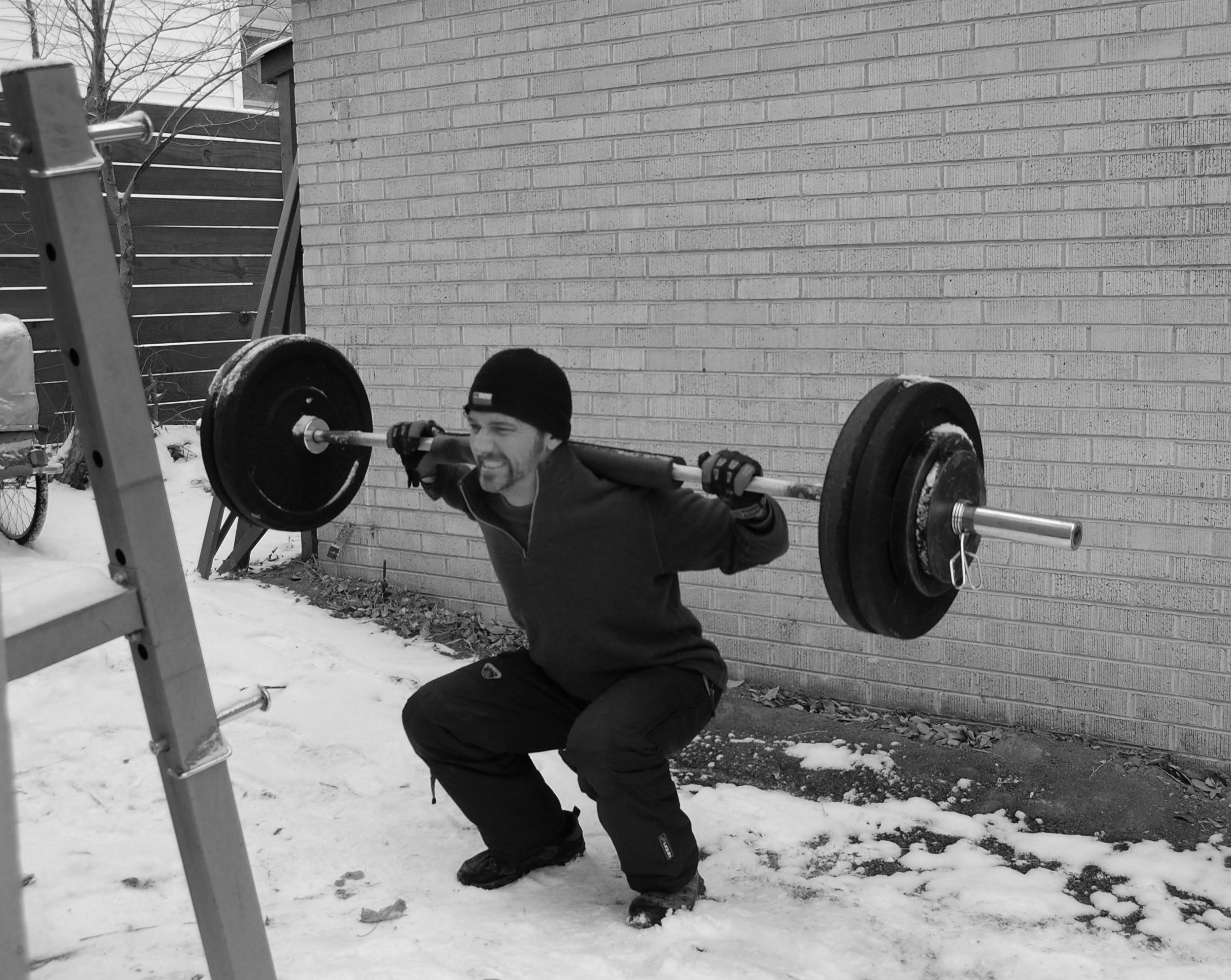
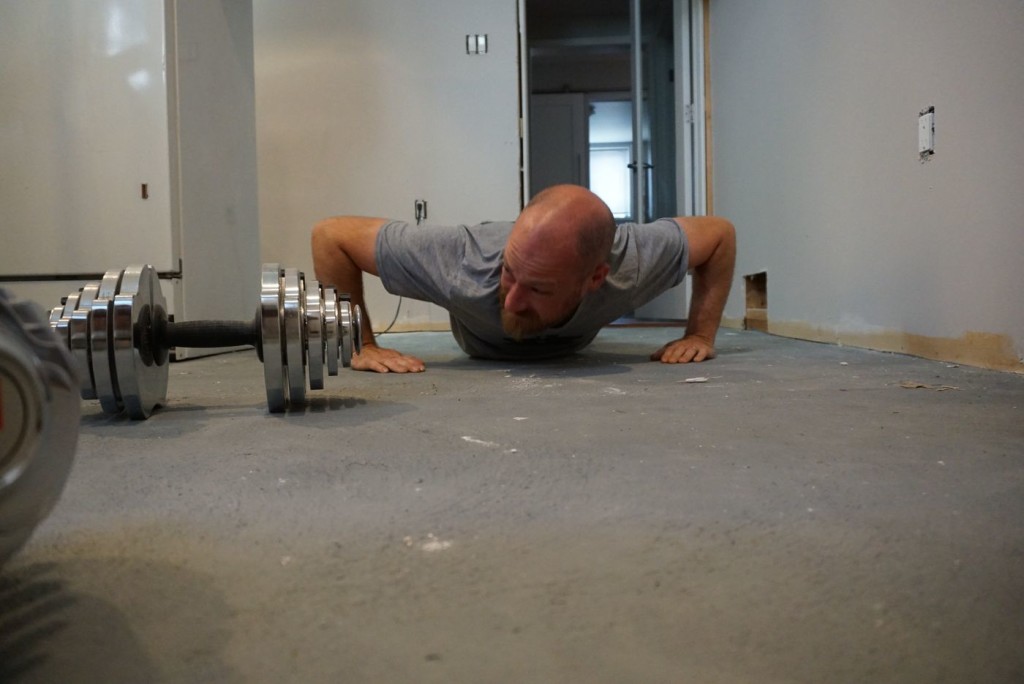
My Brother Wax Mannequin and I poached multiple playground, hotel, and basement gyms during an extended road trip together - August 2016
If you look around on the street these days, you might get the impression that it is really, really difficult to stay in shape beyond the age of about 30.
Sure, there are a few competitive athletes, movie stars and Navy SEALs around that still manage to keep in strong form, but if you are not willing to devote your entire life to training, you might as well just head straight for the stretch pants, right? Older age strikes and there is nothing you can do about it.
Oddly enough, if you could peer at the financial statements of your fellow citizens, the story might be similar: consumer debt is normal, the bills keep piling up, and only the movie stars and athletes (and corrupt CEOs of big banks, of course) make enough money to actually get ahead.
These opinions are widespread, and often fiercely defended as Truth. This is why I have been happily surprised over the years as I discovered that the prevailing wisdom is completely wrong: it's not only possible to become wealthy on an average salary, it is just a natural byproduct of living a healthy life. Similarly, you don't need a crushing workout schedule, a $250 per month gym or a team of professional trainers to be in very good shape. You just need to focus on the basics and avoid the worst pitfalls.
But as the years go on and I talk to more and more people, I realize that very few people even know these basics, and they think some of the pitfalls (for example drinking a big glass of orange juice with breakfast) are actually healthy life choices. So with New Year's Resolution time approaching, I thought we could dish out some of this old school knowledge right now.
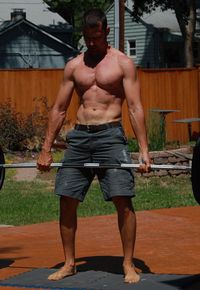
Fig.1: MMM enjoys a brief zero dollar workout on the patio.
Let's use plain old Mr. Money Mustache as an example. I'm an average 42-year-old white nerd who has never played a competitive sport in his life. I made my career in office work and enjoy beer a bit more than I should. And yet I feel great - despite the fact that I keep getting older and live a deprived life without the personal trainer or private chef that every wealthy person really deserves.
Even worse, I don't even have a gym membership, and the months I spend away from home every year have been compromising my access to even the basic backyard barbell set that comprises my only fitness equipment. I have spent about 2 of the past 5 months away from home, which means a lot of time with no gym in sight.
All of these factors, yet all systems seem to be better than ever. Returning from the latest travel binge, I found roughly the same level of strength and bodyfat while keeping the same overall weight on the scale. How can this be?
Fitness as a Part of Life
(rather than something you do at the gym)
Far too often in modern life, we cut an artificial line between the ideas of getting in shape and everything else we do. People train for Ironman events, but then drive a car for local errands. They use the stair machine in the gym, but then take the elevator up to the 12th floor in the office building. They claim that getting in shape is important, but then drive their kids to school in the morning in one of the world's most ridiculous spectacles of Car Clown behavior.
We sit still at work, sit in automobiles, and stand still with rolling luggage on the airport escalator to avoid the strain of the staircase, and hire contractors to take care of our lawns and shovel our driveways. And then we wonder why we get fat, or injure our knees and backs, or get any other less-than-satisfactory performance from our bodies. Only the most dedicated workout junkies (rebranded as CrossFitters these days) seem to get anywhere, and even they often fall off the wagon and become mortals eventually.
I feel that there's a better way to get good health results, but with much more efficiency than what most people achieve right now. You could boil it down to the philosophy of "use it or lose it".
Principles of Efficient Physical Fitness
Not everybody likes the act of exercising itself, but everybody likes being in shape. The key to getting the latter without having to commit your life to flawless execution of the former is to understand the concept of exercise efficiency - getting the best results with minimum time and minimum risk of failing due to bad habits.
Principle Zero: Moving is Normal, Sitting Still is Hazardous
Before we even begin, we need to make a change to the most basic paradigm of modern life. Most of us sit or lie down almost constantly: to sleep, eat, work, drive, and even (shudder) to watch TV. Instead, I like to think of sitting as something you do as a short break from your real life. And you should feel just a bit uncomfortable when sitting down, because it really is a hazardous activity.
Whenever you get a chance to move, take it: get up and pace around while you read books. Attend your conference calls with a mobile phone headset while out walking along the river. Cut your own lawn. Walk the 5 miles across town that you would normally drive. Always, always take the stairs. Never, ever use a drive-through. You can even try taping your laptop to the drink platform of a treadmill and working as you pace slowly along at 1 MPH (I have tried this and it is amazing).
If you're thinking of taking on a job that requires more than a few minutes of car driving per day, consider this equivalent to accepting a job in an Asbestos mine or an old Russian nuclear power plant. You might still do it, but only if the benefits greatly outweigh the obvious costs. Similarly, if you're considering spending an afternoon on the couch watching football, pretend that you have to wear an inhaler that dispenses just a tiny dose of Cyanide into each breath. With this comparison in mind, you can decide if you still weight the passive entertainment more highly than, say, taking your kids out to play in the park.
On really good days, I might spend 4-10 hours walking or biking around for various reasons like errands, carpentry, and just plain old strolls, and these really good days result in incredible happiness. On days when I fail to obey this Principle of Constant Movement, I instantly devolve into a more average and grumpy person.
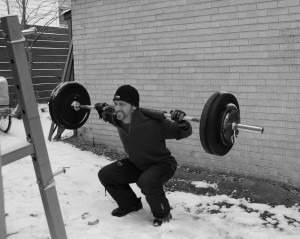
I don't have room for an indoor home gym at the moment. So instead I keep this squat rack just outside my back door, to eliminate psychological barriers to the most important exercise. Mud, snow, hot, cold - it's all good for you - just do some damned squats, at least a couple times per week.
Principle #1: Building Muscle is Far More Effective than Cardiovascular Training
I think the most common beginner fitness mistake in the world might be when people decide to start jogging or other aerobic exercises as a method of weight loss. Double Fail Points if you go for a treadmill or a stationary bike while watching TV inside a smelly commercial gym.
So many people slave away at these cardio-related things like aerobics classes and treadmills and still look almost the same several months later. Most of them end up quitting as they lose motivation in the face of the poor results. And then the weight loss industry is right there waiting, saying they must have just bought the wrong diet shakes. Or the "accept yourself as you are" movement tells them that body composition change is impossible, so you should give up.
The real reason for the failure is that cardio training activities (while great for your heart) are very poor at triggering the growth of muscle tissue. You pump the heart and breathe vigorously and burn a few calories during that brief session, but then the session ends and you're back to your regular self.
On the other hand, people who lift or move heavy things get triple benefits:
- The same heart and lung bonus up front as they lift weights and break down existing muscle tissue
- The massive calorie implosion required to rebuild those muscles to a new, stronger size
- Then a permanent ongoing burn required to maintain that fine new stronger form
As Tim Ferriss demonstrates in the Four Hour Body, it is possible for a relative beginner to trigger over a pound of muscle growth (3500 calories of body composition change) with just one brief session of barbell squats.
Let me repeat that in different terms: you exceed the calorie burn you'd get from 4-8 hours of riding a stationary bike in the gym, in about 4-8 minutes, by warming up your legs and then performing a few sets of 5 squats, working up to a weight that is fairly difficult for you.
To clarify this after many angry and skeptical comments below: YES, the squats themselves burn only a few dozen calories. But by breaking down the tissues of your largest compound muscle group including quadriceps, hamstrings, gluteus, and a plenty of assisting muscles, you force your body to rebuild the entire set bigger and stronger. This is an incredibly calorically-intense process which can take almost a full week to complete. Thus, the total net energy cost ends up being several thousand calories.
Calorie testing on myself over the years confirms these figures are roughly correct - hell hath no appetite like that of a person who has done his or her squats properly. As long as you refuel from this hunger in a strategic manner, you'll find your fat reserves getting vacuumed away at high speed.
How do we take advantage of this? Start thinking about feats of peak strength rather than the conventional 30-minute periods of sweaty endurance training on a stationary bike.
Principle #2: Every Bodypart, Whenever Possible
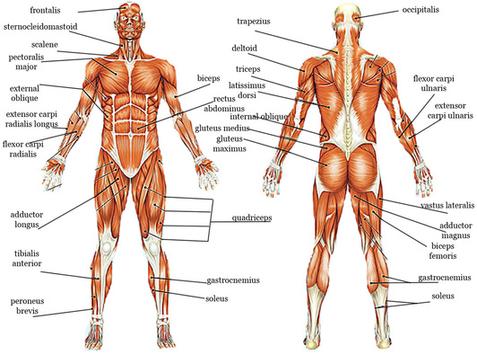
These are your muscles. Understand the big groups, then work them regularly.
Most people think of exercise as all one big interchangeable thing: "I get plenty of exercise walking my dogs and gardening", or, "I was able to drop my gym membership because I bike to work now."
This is the wrong way to think about it.
Sure, mild exercise is still far better than sitting still. But you get much better results if you think about each muscle group and make sure you have overloaded it recently, thus sending it the message to become stronger.
As a start, you could think of your body as having five groups:
- Legs
- Back
- Chest and triceps (your "pushing muscles")
- Upper Back and biceps (any time you find yourself "pulling")
- Core (all the complex muscles that hold you together at the middle)
Now, how will you overload each group at least a little bit, every day or two?
If you like to go to a gym, and you use the free weight room instead of the inefficient cardio stuff, great. Through my teens and 20s, I was on this plan and it went well. But after getting married, then becoming a father, I found that long stretches of time would pass as I became complacent and made excuses. This is not great - to improve from wherever you are now, you need every muscle group to be blasted down with reasonable exertion (enough to cause at least a tiny bit of soreness) - every week.
To translate the vague concept of muscle groups into practical exercises you can do in many places, here's a guide of my favorite exercises. You can look these up anywhere to get the basics of how to do each movement safely. For example, Google "How to Do Squats".
Legs:
- Squats (with just your own weight when getting started. Then with barbells, or one-legged if no barbells available)
- Deadlifts
- Jumping on or off of anything (including boxes like this one)
- Running up and down stairs
- Sprinting around anywhere
- Urban Parkour-style hooliganism with friends when visiting any city
- Note that my daily cycling doesn't count as a real leg exercise, since it's a heart-building rather than muscle-building exercise.
Back:
- Pullups from any bar or overhanging surface. You can assist yourself with your legs if you're not yet strong enough to do real pull-ups.
- Barbell or dumbell rows
- Pulling any heavy item from the ground to your chest while you're bent over.
- Snow shoveling, digging trenches, chopping wood, moving bags of concrete
- And anything else that feels like hard work is probably good for your back.
- The Deadlift, mentioned under "Legs", is also great for your lower back.
But build this strength up slowly if you're untrained - we've all heard stories about unfit people who "throw out their backs" when lifting something after years of deadly inactivity. The goal here is to make your back unbreakable - for life.
Chest and Triceps:
- the Clean and Press (lift a barbell from the ground to over your head - my second favorite exercise in the world after squats).
- bench press
- dumbbell press
(these first three are generally only if I'm lucky enough to be at home) - dips
- pushups
- On the road, the barbells are unavailable so I try to increase to 100 pushups per day, and using any available parallel surface, inside corner of a kitchen countertop, or pair of posts for dips.
- To increase resistance, you can get a friend or loved one to sit on your back during pushups: 8 insanely hard pushups are better for you than 50 easy ones.
Core:
The benefit of doing real-world exercise (especially sprinting) instead of lame treadmills at the gym, is that it forces you to flex and stabilize all your abdomen and oblique muscles and make them stronger. But you can still target the core directly with a few of my favorites:
- Planks (hover your body flat and still with only forearms and toes touching the ground for 60-300 seconds)
- Leg-raises while hanging from a bar, tree branch, or anything else
- Twisting or jumping motions of any sort
- Situps and abdominal crunches
Important note: core and abdominal muscles do not help you lose abdominal fat any faster than any other exercise. The fastest way to lose fat (after fixing your diet) is to accelerate calorie burn, which means triggering muscle growth. So if you want better abs, do squats.
Principle #3: Resisting Heavy Motion Delivers The Results
Consider the following counter-intuitive trick: walking down a flight of stairs delivers much better strength and muscle-building results than walking up that same flight of stairs, even though going down is much easier. I learned this amazing shortcut just a few years ago, but it has allowed me to get better results in less time ever since.
To put it into practice, you can bend your legs more deeply when going down stairs or hills, lower your body more slowly during pushups and pullups and weight exercises, and in general think about fighting loads as the chief source of strength.
For example: riding a bike won't build much leg strength because it's all concentric (pushing) with no eccentric (resisting). Adding in a few lunges as part of every day (or deep jumps, or squats of any form) will massively increase the benefits.
Principle #4: Turn The World Into Your Gym
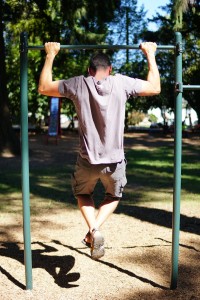
Pull-ups in a public park in Portland this spring.
With these basics covered, we can move to the real world to find ways to apply them. You will never miss a workout again, because from now on the entirety of every day you live will be a workout. With your eye on potential ways to overload your muscles, opportunities will come out of the woodwork. So let's make all this work in Real Life:
Walk and Run for Transportation- and Borrow Bikes when you Travel
Sidewalks and roads. Curbs and airport and hotel staircases. These are all amazing fitness machines, disguised as boring urban infrastructure. By seeking them out during travel, opportunities to stay fit magically materialize.
For example, when visiting people I make a point of borrowing one of their spare bikes if available. You can also install the Spinlister* app on your phone, and rent bikes from locals - instead of cars from bland international rental car chains - whenever you're on a trip.
As a result, I have enjoyed bike tours of dozens of US cities and even a good number of international spots that were often the highlight of the entire trip. If you seek to maximize your effort, the benefits come quickly.
Lunge Whenever Nobody's Looking
You can transform the mild benefits of walking into a shockingly fast muscle builder you can do anywhere, just by learning how to lunge. The effectiveness comes from the fact that you're causing peak muscle overload in a mostly-eccentric (downward) motion. I recently did one lap of deep lunges around a soccer field (which took all of about 90 seconds), and it was enough to give me pleasantly sore legs for two days.
Even better, you can explain that paragraph above to your friends, and challenge them to lunge a block together on as part of an evening outing - for example on your way out to happy hour. You'll love the fun of doing this ridiculous thing together in public, and the reactions you'll get from the strangers, almost as much as you love your new <arnold voice> sculpted and bulging quadriceps and buttocks muscles </arnold>. Pain equals gain!
Sprint Whenever you Can
Performing just a single 10-second sprint across a park or a parking lot can change your body for the better. But you can also apply this principle on the bike, or during a set of pushups, or even when shoveling a driveway of snow. Any time you want to become better, challenge yourself to max out for the next ten seconds!
Whenever you go to peak exertion, you are telling your body it is time to grow. If you stay within your comfort zone, the body decides it is fine as it is. Sprinting will send your body this change signal, in almost every situation.
100 Pushups per Day
Or even 10 pushups if you're new to the pastime. I love this exercise because it is so efficient: If I move as quickly as possible, I find it takes only 15 seconds to do 25 pushups. Since it is such a small commitment, it's easy to keep to it four times throughout the day, resulting in a reasonable strengthening of the chest and associated muscles with a total time investment of one minute.
Pro Tip: I make myself drop for 25 or 50 pushups every time I am going to indulge in something questionable like a beer or a high-carb snack, to help compensate for the negative effects before they happen.
Playgrounds and Gym Poaching
Saving the best for last: although your own fancy gym may be far off in another country when you're traveling, there is almost always a public park with a play structure that can provide many of the basics for free. You can sprint and do pullups, dips, jump off of high things and land dramatically in the sand, do situps, chase kids around, and generally get a surprisingly good workout.
Bonus Principle: Sugar is the Devil, Fat is your Friend
The tips above will make a huge difference in any life that is currently too sedentary. But your body will fight to keep its fat reserves, and it will win this fight, if you obey its requests for constant sugar and carbohydrates.
For details I will refer you to Mark Sissson's primal blueprint, or Tim's Slow Carb Diet. But for me the basics are really simple: I avoid bread, pasta, and any desserts or sugary drinks including fruit juice. And the idea of buying soda for home consumption or even ordering one at a restaurant is as horrifying to me as drinking drain cleaner. If your goal is fat loss, Do Not Drink Calories!
Instead I eat mostly vegetables, nuts, eggs, oils (mostly olive but with no rules against butter and coconut oil!) and an average amount of minimally processed meats and dairy. It's your basic low-carb diet, and I've found a 100% correlation between bending the rules of this diet (occasional pizza and beer), and the rapid softening of my waistline. If you haven't tried this way of eating yet, you might be pleasantly surprised with how easy it is.
Related Article: The Amazing Waist-Slimming, Wallet-Fattening Nutrient
That's it. Sure, there is much more to fitness than these five principles, but they are big ones, and enough go get started. This is infinitely better than not getting started, so let's go.
Further Reading:
The New York Times, on why exercise should be a rewarding part of your daily life, not just a chore you treat like a health prescription.
Gary Taubes writes and rants about how our high-sugar, high-carbohydrate diet is the source of most of our problems. I saw some of his articles in the NYTimes, then moved on to read his book "Why We Get Fat." I'm torn on this, because there is still scientific debate on the ideal diet and some reputable doctor friends disagree with me. But my own results and a recent rigorous blood test are good enough to keep me very enthusiastically on the high fat, high-vegetable, low-carb diet.
Klaus Obermeyer, now 96, inspires you by refusing to age, citing benefits of keeping active as the decades pass.
*Spinlister is a pretty cool invention and I want them to succeed. If you're visiting Longmont (for example to do a DIY bike-powered version of the brewery tour), you can rent bikes from the impressive fleet of one of my friends - his are all the bikes you see on the East Side. You can use my referral code for a $5 credit if desired.